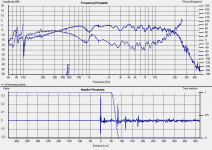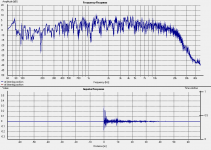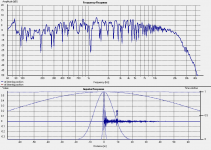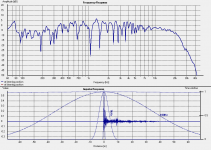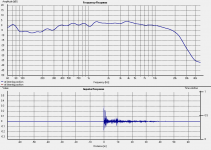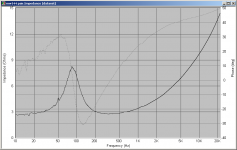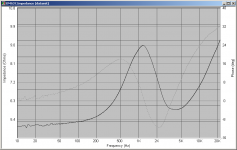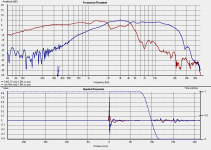Example - Honda - not the best cars in the world in many senses, etc.
But best motors near BMW and Ferrari 🙂 A Honda Civic type R is something 😀
Hmm, I've owned Ford, SAAB, Mazda, Toyota. Sound like I need to have a closer look at Honda's. While I was in the US, they did not seem to come out well in some reliability statistics as published in Consumer Reports. Their mufflers seem to have a short life.
Last edited:
I've had a civic and I loved it. Best value sports car ever - the NSX.
George - as I said, Honda does not lead in reliability, or performance, or fuel economy, or ... but in the US they are #1 in customer satisfaction and loyalty. They have had the best selling sedan (Accord) for so many years that no one even looks at the numbers anymore. They are #1 in lowest cost of ownership (Accord). They do not target being anything but what makes for a good value. #1 in "warranty" is not a good value - 0 defects is too expensive.
My 1999 Accord has 200,000 miles and runs like a clock. Cost of ownership - about $100 per month or less. (Original muffler!!)
When I was at Ford the line was always "Well how does Honda do it?" They were the reference for all that was "done right".
George - as I said, Honda does not lead in reliability, or performance, or fuel economy, or ... but in the US they are #1 in customer satisfaction and loyalty. They have had the best selling sedan (Accord) for so many years that no one even looks at the numbers anymore. They are #1 in lowest cost of ownership (Accord). They do not target being anything but what makes for a good value. #1 in "warranty" is not a good value - 0 defects is too expensive.
My 1999 Accord has 200,000 miles and runs like a clock. Cost of ownership - about $100 per month or less. (Original muffler!!)
When I was at Ford the line was always "Well how does Honda do it?" They were the reference for all that was "done right".
Last edited:
This is very interesting. The Accord is also a very popular sedan here as well. I've driven the civic too. It does have a nice light feel. My Toyota Exsior of 1990 has 350,000 Km on it. What is interesting is that the fuel mileage has been increasing with the total mileage. Cost of ownership is also around $100 USD including replacing worn out parts. Still driver like a charm, contantly ahead of the pack when I pass a toll booth on the highway. Of course this is a tweaked version (didn't think I'd be satisfied with the standard thing). I actually wish I were able to do some measurements on the exhuast system tried some mods that worked real well on at high speed, but just did not feel right in cities.
Guys, when you post measurement graphs, could you also list the measurement conditions -- mic position, gating, smoothing, etc.?
Guys, when you post measurement graphs, could you also list the measurement conditions -- mic position, gating, smoothing, etc.?
What do you think about this measurement ? 😀
An externally hosted image should be here but it was not working when we last tested it.
Last edited:
What do you think about this measurement ? 😀
An externally hosted image should be here but it was not working when we last tested it.
I am not that familiar with the NSX, but that one looks like it has been tricked out a bit.
Is that one yours?
I've had a civic and I loved it. Best value sports car ever - the NSX.
Now that we are off topic, officially, I think the Porsche GT3 may just best the NSX for value. 🙂
Of course, I just may be a little bit biased.
An externally hosted image should be here but it was not working when we last tested it.
Just passed 50,000 miles (owned since it had 4,500 miles) and the only problems I had in the 3 years of driving was a sticky ignition key and a oil seal on the back of the engine (all under warranty). Drive it everywhere, rain or shine.
Got to admit, that NSX is gorgeous!
Last edited:
I am not that familiar with the NSX, but that one looks like it has been tricked out a bit.
Is that one yours?
I would like 😱 but it 's a photo from the internet.
Mine is this one, less sportive, more confortable but with a big motor 😎
An externally hosted image should be here but it was not working when we last tested it.
An externally hosted image should be here but it was not working when we last tested it.
An externally hosted image should be here but it was not working when we last tested it.
I just replace the Nokia speaker driver 😱 by Focal and audax for the sub.
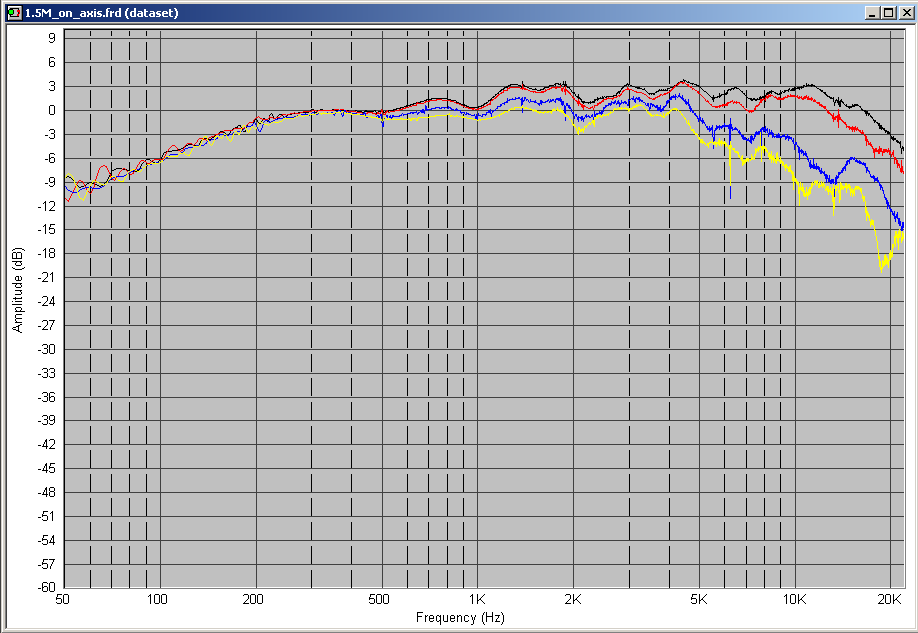
The thing that stick out to me in this graph is that you're top octave is down approx 10 dB at 45 degrees while 1-4 k is down only 3 dB and it doesn't drop at a consistent rate. It would be nice to have measurements that go even further off axis as they may explain the harsh sound you heard. My experience has had a correlation even if it may not completely explain the causation. The crossover looks fine as best I can tell from those.
Soongsc might be able to tell you how to treat the room to get a better perceived balance of power even though you may not think it's a problem. I'd bet it actually is. Further off axis may reveal more. It seems daunting and pricey if possible.
Notch filter: If it's too broad, make the coil smaller and the cap larger by the same factor to narrow it and keep your frequency the same. There seems to be a limit to how deep it can be made--where adding more resistance will actually make it less deep. Maybe some one will comment on that. If the woofer's too bad it can't be corrected, but that doesn't look like an issue with what you've shown. I personally want to find a woofer with excellent off axis performance. What are you using? It would be great if you could off axis measurements of it to 90 degrees w/o any filters in place. The first break up resonance can change frequency further off axis as seen in my graph.
The other graph I'd like to see for diagnosis is a room response graph at seated position. All I'd really look at in this is where the room is modal and what response you are getting there. IOW, how deep and smooth is the bass in your listening position. I believe a full frequency sweep has more to tell us from this position, but more difficult to interpret.
This is my room response of my 2-ways from fiver different locations across my couch:
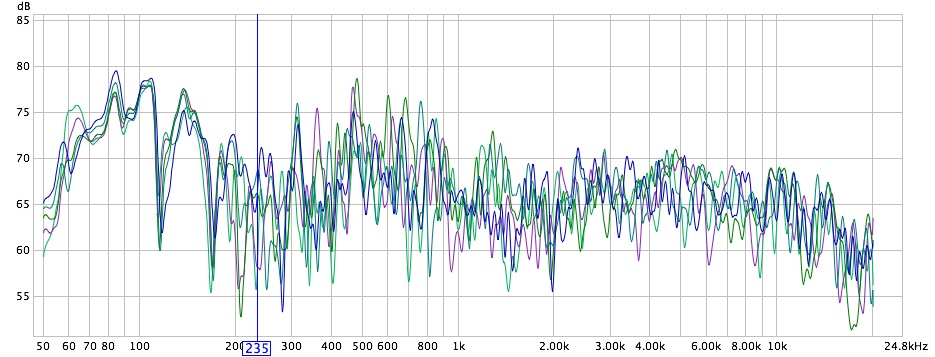
You can see from here that my room goes modal just below 200Hz.
Subs are being purchased today 🙂
Thank you for posting the graphs. I think it's the only way we'll learn anything. Data can be tricky, but it's clearer than talk.
Dan

One other thing to add: with that broad of dispersion in the lower range of the tweeter, off axis woofer response will not be as important as it is in this:
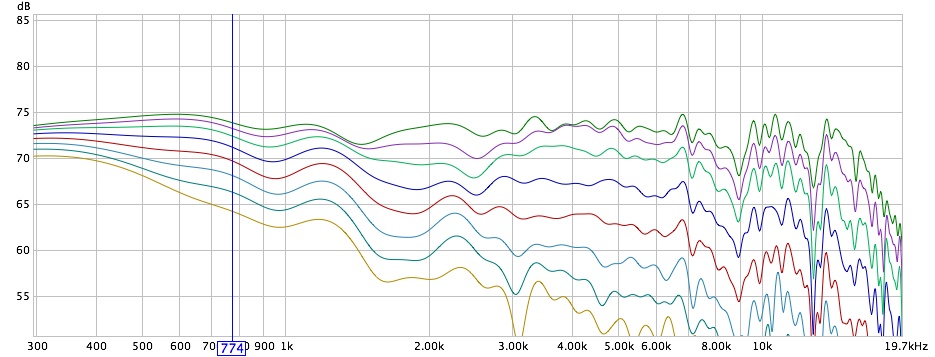
or this courtesy of http://www.gedlee.com/Nathan.htm:
An externally hosted image should be here but it was not working when we last tested it.
Dan
Hi Earl, thanks for the response 🙂
perhaps I should have qualified that there are a few measurements that there is no absolute consensus on 🙂 I think you said yourself earlier that you don't put the same importance on certain measurements as what others do, (I think S Linkwitz and J D'appolito were mentioned).
Yes and after listening to some very inaccurate speakers for 20+ years it is quite possible that my preference is skewed, simply because my brain has adjusted to that particular sound, and maybe learning to like accurate sound will take some more time. However I have been striving for accuracy, what I am not yet able to deduce is whether it is my subjectivism that is dominating, or whether It is that I am misinterpreting "accurate" and in fact my subjective preference IS for the more accurate.
Yes as always there is more and more to learn!! Part of the problem for me is that there was a four year gap between when I read a lot of this stuff and when I got back to actually using it, so I really need to re-read a lot. There are fragments there, but definitely not the whole picture (even when it was fresh there wasn't!!).
Something that a lot of companies should take heed of!! Companies that I would previously have recommended because of the good value of their products, I no longer would. Simply because whilst before they made good products that lasted and were well engineered at a decent price. Now the products are a similar price to before, but the quality is much poorer, and the after sales service is almost non-existent. It seems that in the efforts to make more money to please shareholders, a lot of companies are becoming extremely short sited, and are effectively starting to seal their own fate. Unless of course ALL companies follow the same line and us as consumers have no other choice than the best of a bad bunch. Surely there will eventually be a backlash against this though, and quality of product and service will once again start to be the number one priority.
Tony.
HI Tony Several disagreements
1) most experts that I know are fairly well in agreement on what needs to be measured and how to interprete the results. Most DIY are not.
perhaps I should have qualified that there are a few measurements that there is no absolute consensus on 🙂 I think you said yourself earlier that you don't put the same importance on certain measurements as what others do, (I think S Linkwitz and J D'appolito were mentioned).
2) Subjective plays a very important role when you goal is "preference" as you clearly state that yours is. However, "accuracy" does not require this same dependence on the subjective. You have to decide if what you want is "preference" or "accuracy" - they will almost never be the same in the short term - longer term they probably will - because "preference" is not a stable assesment. It can and does change with the environment, time of day, person, mode and on and on. Its a moving target.
Yes and after listening to some very inaccurate speakers for 20+ years it is quite possible that my preference is skewed, simply because my brain has adjusted to that particular sound, and maybe learning to like accurate sound will take some more time. However I have been striving for accuracy, what I am not yet able to deduce is whether it is my subjectivism that is dominating, or whether It is that I am misinterpreting "accurate" and in fact my subjective preference IS for the more accurate.
3) most of the "peaks and dips" things that you discuss have been quantified. Knowing the liuterature goes a long ways to helping with interpretation.
Yes as always there is more and more to learn!! Part of the problem for me is that there was a four year gap between when I read a lot of this stuff and when I got back to actually using it, so I really need to re-read a lot. There are fragments there, but definitely not the whole picture (even when it was fresh there wasn't!!).
Regarding engineering - its no different than anything else, all aspects of a company have their point of view. After doing engineering for 40 years I have reached one conclusion - only when all of these aspects agree on one thing, and that is "customer value", does it all work.
Something that a lot of companies should take heed of!! Companies that I would previously have recommended because of the good value of their products, I no longer would. Simply because whilst before they made good products that lasted and were well engineered at a decent price. Now the products are a similar price to before, but the quality is much poorer, and the after sales service is almost non-existent. It seems that in the efforts to make more money to please shareholders, a lot of companies are becoming extremely short sited, and are effectively starting to seal their own fate. Unless of course ALL companies follow the same line and us as consumers have no other choice than the best of a bad bunch. Surely there will eventually be a backlash against this though, and quality of product and service will once again start to be the number one priority.
Tony.
The thing that stick out to me in this graph is that you're top octave is down approx 10 dB at 45 degrees while 1-4 k is down only 3 dB and it doesn't drop at a consistent rate. It would be nice to have measurements that go even further off axis as they may explain the harsh sound you heard. My experience has had a correlation even if it may not completely explain the causation. The crossover looks fine as best I can tell from those.
Hi Dan, I did try taking measurements at bigger angles off axis but was getting nonsense results. It was a bit odd as the first time I tried (but wasn't measuring the angles) I was able to get a good measurement even at 90 degrees, but the second time I tried I was getting horrid results that were completely unusable (basically looked like + or - 20db at very close intervals across the freq range. I couldn't get any gating that worked and I would probably need to do the measurements outside on the balcony with the woofer facing out into the open to get some meaningful results. I think that the woofers are actually quite non directional up to the point (4K where they start running out of steam). The tweeter is semi horn loaded which might explain it's tendency to become rapidly more directional at higher frequencies.
Oh I can assure you that there could be improvments made!! 🙂 the at listening position response is quite horrible looking. See the attached graph!! 🙂Soongsc might be able to tell you how to treat the room to get a better perceived balance of power even though you may not think it's a problem. I'd bet it actually is. Further off axis may reveal more. It seems daunting and pricey if possible.
I did play with this quite a bit in the sim, but didn't find anything that seemed to work very well (except when I ran the optimise and it came up with a 50uH coil with a 2000uF capacitor!!! something that I thought was a little impractical!!Notch filter: If it's too broad, make the coil smaller and the cap larger by the same factor to narrow it and keep your frequency the same. There seems to be a limit to how deep it can be made--where adding more resistance will actually make it less deep. Maybe some one will comment on that. If the woofer's too bad it can't be corrected, but that doesn't look like an issue with what you've shown. I personally want to find a woofer with excellent off axis performance. What are you using? It would be great if you could off axis measurements of it to 90 degrees w/o any filters in place. The first break up resonance can change frequency further off axis as seen in my graph.
Oh ok maybe my room isn't so bad afterall!! I thought it was odd that there were peaks 2k 4k 6k 8k and corresponding dips at 1k 3k 5k 7k... Is your graph a raw response or is that with gating?? from memory, without the gating mine looked even more scary than yours! 🙂The other graph I'd like to see for diagnosis is a room response graph at seated position. All I'd really look at in this is where the room is modal and what response you are getting there. IOW, how deep and smooth is the bass in your listening position. I believe a full frequency sweep has more to tell us from this position, but more difficult to interpret.
This is my room response of my 2-ways from fiver different locations across my couch:

You can see from here that my room goes modal just below 200Hz.
Subs are being purchased today 🙂
Thank you for posting the graphs. I think it's the only way we'll learn anything. Data can be tricky, but it's clearer than talk.
Dan
Attachments
Last edited:
No gating. Just five sine wave sweeps from across my couch 1/12 octave smoothing laid overtop of one another. Check out the link in my signature for more info on what we hear. I don't know if you're up on that or not, but don't pay too much attention to the room response above the modal region though I believe it does have some degree of usefulness.
One other thing, don't be afraid to show the ugly truth. Looks like your gate is at 500Hz (ish). The room response won't tell us anything gated like that other than a bit about your comb filtering. What I'm interested in from the room is the bass as it can only be measured in the room and it plays a large role in tonal balance and enjoyment of your system.
Dan
One other thing, don't be afraid to show the ugly truth. Looks like your gate is at 500Hz (ish). The room response won't tell us anything gated like that other than a bit about your comb filtering. What I'm interested in from the room is the bass as it can only be measured in the room and it plays a large role in tonal balance and enjoyment of your system.
Dan
Last edited:
warts and all 😉
OK Well here is the completely raw response roughly at my listening position on my lounge. It is roughly because I had trouble getting my mike to sit properly so it is a little bit lower than it should be, probably about 15cm lower.
Also attached for comparison is 1/32 octave smoothed (using holm impulses complex smoothing as it shows the dips much better) and 1/16 octave smoothed. and just for the fun of it a 1/3rd octave smoothed (normal amplitude smoothing) curve. You can see why manufacturers show graphs with 1/3rd octave smoothing!! The hump at 60Hz I suspect was a car driving into the garage downstairs as I was taking the measurement. The woofers should be down about 10db at that point. Resonant freq of the box is around 82Hz, the intention is to cross to the subs at 200Hz.
Oh and I forgot to answer your query as to what my woofers are. The are Morel MW144's. If you saw the near field response earlier in the thread, then you will be able to tell that pretty much all of the response irregularity up to 2Khz is either baffle diffraction or room interaction.
Tony.
OK Well here is the completely raw response roughly at my listening position on my lounge. It is roughly because I had trouble getting my mike to sit properly so it is a little bit lower than it should be, probably about 15cm lower.
Also attached for comparison is 1/32 octave smoothed (using holm impulses complex smoothing as it shows the dips much better) and 1/16 octave smoothed. and just for the fun of it a 1/3rd octave smoothed (normal amplitude smoothing) curve. You can see why manufacturers show graphs with 1/3rd octave smoothing!! The hump at 60Hz I suspect was a car driving into the garage downstairs as I was taking the measurement. The woofers should be down about 10db at that point. Resonant freq of the box is around 82Hz, the intention is to cross to the subs at 200Hz.
Oh and I forgot to answer your query as to what my woofers are. The are Morel MW144's. If you saw the near field response earlier in the thread, then you will be able to tell that pretty much all of the response irregularity up to 2Khz is either baffle diffraction or room interaction.
Tony.
Attachments
First of all, I would seriously try to get the minimum impedance above 6Ohm unless the amp really can double the output power when you half the load impedance. Second, I would try to get the speaker impedance as constant as possible. Normally I try to get as close to 2Ohm diff between min and max with the least components possible.
During SPL measurement, if you have the ref input connected to the input of the amp instead of output of the amp, then the amp is part of the DUT.
Hi soongsc, unless I run only one woofer, then getting the impedance up to 6 ohms is going to be next to impossible. I'm currently running an LM3886 chipamp, and it is not even getting warm. Also I'm planning on running with a 2nd order active cross to my subs at 200Hz so the amp won't be struggling so much.
I had considered putting a zoble on the tweeter to flatten it's resonant peak. The impedance peak between 3 and 4k is the notch filter, and the tweeters impedance rises naturally as well, flattening it would I would think cause the high freq to rollof to be much higher than it already is.
Impedance curves of the woofers in box and the tweeter (in box) are attached. I think you will see from them that I will really struggle to flatten the impedance without totally destroying the sound 🙂 The tweeter is supposed to have a resonant freq of 700Hz so it is quite a way off that!
edit: since I hadn't posted individual responses before I've added the woofer and tweeter measurements at 1.5M on axis Mic level with the tweeter and 1.36M off the ground, 1.2M from the ceiling and around 1.3M to the nearest furniture either side. These measurements combined with the impedance measurements are what I've been using in speaker workshop for my sims.
Tony.
Attachments
Last edited:
Yes and after listening to some very inaccurate speakers for 20+ years it is quite possible that my preference is skewed, simply because my brain has adjusted to that particular sound, and maybe learning to like accurate sound will take some more time. However I have been striving for accuracy, what I am not yet able to deduce is whether it is my subjectivism that is dominating, or whether It is that I am misinterpreting "accurate" and in fact my subjective preference IS for the more accurate.
Tony.
Hi Tony
A very enlightened response.
Preference is heavily weighted by expectation and expectation can be heavily influenced by previous experince. Thus it is very likely that your current "preference" will be heavily biased towards your previous experience. Breaking this cycle can be difficult.
In my own designs I take the purely "objective" point of view on everything that I do. By this I mean that first and formost I design to "accuracy" to the extent that this is measureable. In other words, I will never do and have never done anything that I can measure as going away from "objective accuracy" no matter what I might think of it subjectively. And I have done several things that measured better, but initialy did not seem right. However I stuck to my premise and as time went on I found that in each and every case my initial reaction was incorrect.
Hence, in my own experience I have found that accuracy and preference are closely aligned, but only in the "steady state". There are initial "preference" judgments that are quite different than the long term ones, and, just like a transient, they can fluctuate and reverse themselves until they settle in on the steady state. I have always found this steady state to be completely aligned with objective measurements.
This "transient" perception issue is why I do not show at the audio fairs. The expectation gets completely blurred from all of the "bad" products and there is no "steady state" possible. Hence the "preference" judgements are all over the map and there is no consistancy what-so-ever. On the other hand when people come here they often stay and listen for an hour or more. The judgements have been very consistant and again completely aligned with objective measurements.
It all makes sense.
Yes and after listening to some very inaccurate speakers for 20+ years it is quite possible that my preference is skewed,
Take a week off. It helps me "clear my head" when I get frustrated trying to figure things out.
Rob🙂
- Status
- Not open for further replies.
- Home
- Loudspeakers
- Multi-Way
- Measurements: When, What, How, Why
